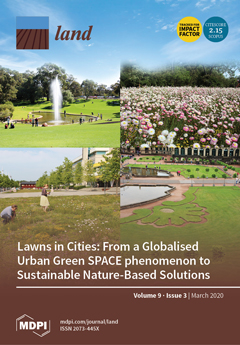Farmland abandonment is considered as an important phenomenon for changing eco-environmental and sociocultural landscapes of mountainous rural landscape. Many studies have analyzed farmland abandonment, its driving factors, geophysical processes and consequences at landscape: however, very few have focused on mountainous developing countries such
[...] Read more.
Farmland abandonment is considered as an important phenomenon for changing eco-environmental and sociocultural landscapes of mountainous rural landscape. Many studies have analyzed farmland abandonment, its driving factors, geophysical processes and consequences at landscape: however, very few have focused on mountainous developing countries such as in Nepal, which is a rapidly urbanizing country suffering from serious farmland abandonment. Therefore, our study was an attempt to (i) assess the spatiotemporal extent of farmland abandonment in Nepal, (ii) explore driving factors of farmland abandonment, and (iii) discuss on the eco-environmental and sociocultural consequences in Nepal. We reviewed various literature, documents, and national reports to obtain a dataset pertaining to the overall status of farmland use and changes along with political and socioeconomic changes, economic development processes, and policy and governance in Nepal. Our results showed that farmland abandonment is widespread; however, it is more prevalent in the hilly and mountainous regions of Nepal. A total of 9,706,000 ha, accounting for 23.9% of the total cultivated farmland in Nepal, was abandoned during the period of 2001 to 2010. The driving factors included population growth, scattered distribution of settlements, urbanization, socio-economic development, poor access to physical services, and poor implementation of agriculture development policies. Furthermore, the increasing extent of natural disasters, malaria eradication, land reform and resettlement programs, the complex system of land ownership, land fragmentation, political instabilities, and the intensification of trading in agricultural products also acted as drivers of farmland abandonment in Nepal. Farmland abandonment generates negative effects on rural societies eco-environmentally and sociologically. Abandoned plots were subjected to different forms of geomorphic damage (e.g. landslide, debris flows, gully formation, sinkhole development etc.). Farmland landscape fragmented into a group of smaller interspersed patches. Such patches were opened for grassland. Furthermore, farmland abandonment also has effects on the local population and the whole society in terms of the production of goods (e.g., foods, feed, fiber), as well as services provided by the multi-functionality (e.g. sociocultural practices, values and norms) of the agricultural landscape. Therefore, this study plays an important role in planning and implementing eco-environmental management and social development processes in Nepal.
Full article





